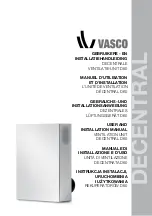
5
Electrical connection
5.1
To do before the electrical
connection
• Make sure that the electrical connection agrees with the
product specification on the motor name plate.
• Make sure that the environment for electrical connection
is clean and dry.
• Make sure that the wiring diagram that is included with the
supply of the product agrees with the terminals in the con-
nection box.
5.2
To connect the product to the
power supply
• Complete the electrical connection for the motor. Refer to
the motor wiring diagram that is included with the product.
• Make sure that the cross section of the protective earthing
is equal to or larger than the cross section of the phase
conductor.
• Install a circuit breaker in the permanent electrical installa-
tion, with a contact opening of a minimum 3 mm at each
pole.
• If a residual current device (RCD) is installed, make sure
that it is an all-current sensitive RCD. Consider if the prod-
uct has a frequency converter, uninterruptible power sup-
ply (UPS), or an EC motor. EC motors have a leakage
current to earth that is <=3.5 mA.
5.3
Speed controller for EC
motors
• EC motors are controlled through a stepless 0–10 V signal.
• Do not use power supply for the speed controller.
• Refer to
and the instruction
manual for the external speed controller.
5.4
Motor protection for EC
motors
EC motors have an integrated motor protection. Reset the
motor protection by disconnecting the fan from power supply
for 60 seconds.
5.5
Speed controller for AC
motors
Note:
The speed controller alternatives are different for different
motor types. Make sure that your motor is compatible with
the speed controller type before you use it.
The speed can be controlled by voltage reduction using a
transformer. It is also possible to control the fan speed with
frequency converter if the installed frequency converter has
built in all-pole sine filter and shielded cables are not needed.
5.6
To install motor protection for
AC motors
• If the product has an built in motor protection, reset by dis-
connecting the product from power for 60 seconds.
• If the motor has temperature monitors such as thermal
contacts (TK) or thermistors lead out into the terminal box,
these must always be connected in the control circuit us-
ing appropriate motor protection.
• Make sure that an overheated motor cannot start again
automatically when it becomes cool.
• Install the motor cables and the temperature monitor apart.
• If the motor does not have temperature monitors, install a
motor protection switch.
5








































